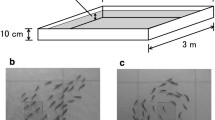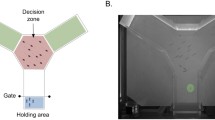Abstract
Collective animal behaviour has attracted much attention recently, but cause-and-effect within interaction sequences has often been difficult to establish. To tackle this problem, we constructed a robotic fish (‘Robofish’) with which three-spined sticklebacks (Gasterosteus aculeatus L.) interact. Robofish is a computer-controlled replica stickleback that can be programmed to move around a tank. First, we demonstrated the functioning of the method: that the sticklebacks interacted with Robofish. We examined two types of interaction: recruitment and leadership. We found that Robofish could recruit a single fish from a refuge and could initiate a turn in singletons and in groups of ten, i.e. act as a leader. We also showed that the influence of Robofish diminished after the first 30 min that fish spent in a new environment. Second, using this method, we investigated the effects of metric and topological inter-individual distance on the influence that Robofish had on the orientation of fish in a shoal of ten. We found that inter-individual interactions during this turn were predominantly mediated by topological, rather than metric, distance. Finally, we discussed the potential of this novel method and the importance of our findings for the study of collective animal behaviour.





Similar content being viewed by others
References
Abramoff MD, Magelhaes PJ, Ram SJ (2004) Image processing with ImageJ. Biophoton Int 11:36–42
Aoki I (1982) A simulation study on the schooling mechanism in fish. Bull Jpn Soc Sci Fish 48:1081–1088
Ballerini M, Cabibbo N, Candelier R, Cavagna A, Cisbani E, Giardina I, Orlandi A, Parisi G, Procaccini A, Viale M, Zdravkovic V (2008a) Empirical investigation of starling flocks: a benchmark study in collective animal behaviour. Anim Behav 76:201–215. doi:10.1016/j.anbehav.2008.02.004
Ballerini M, Calbibbo N, Candeleir R, Cavagna A, Cisbani E, Giardina I, Lecomte V, Orlandi A, Parisi G, Procaccini A, Viale M, Zdravkovic V (2008b) Interaction ruling animal collective behavior depends on topological rather than metric distance: evidence from a field study. Proc Natl Acad Sci USA 105:1232–1237. doi:10.1073/pnas.0711437105
Barbaro A, Einarsson B, Birnir B, Sigurðsson S, Valdimarsson S, Pálsson ÓK, Sveinbjörnsson S, Sigurðsson P (2009) Modelling and simulations of the migration of pelagic fish. J Mar Sci 66:826–838. doi:10.1093/icesjms/fsp067
Biro D, Sumpter DJT, Meade J, Guilford T (2006) From compromise to leadership in pigeon homing. Curr Biol 16:2123–2128. doi:10.1016/j.cub.2006.08.087
Buhl J, Sumpter DJT, Couzin ID, Hale JJ, Despland E, Miller ER, Simpson SJ (2006) From disorder to order in marching locusts. Science 312:1402–1406. doi:10.1126/science.1125142
Bumann D, Krause J (1993) Front individuals lead in shoals of 3-spined sticklebacks (Gasterosteus aculeatus) and juvenile roach (Rutilus rutilus). Behaviour 125:189–198
Couzin ID, Krause J (2003) Self-organization and collective behavior in vertebrates. Adv Study Behav 32:1–75. doi:10.1016/S0065-3454(03)01001-5
Couzin ID, Krause J, Franks NR, Levin SA (2005) Effective leadership and decision-making in animal groups on the move. Nature 433:513–516. doi:10.1038/nature03236
Couzin ID, Krause J, James R, Ruxton GD, Franks NR (2002) Collective memory and spatial sorting in animal groups. J Theor Biol 218:1–11. doi:10.1006/jtbi.2002.3065
Dyer JRG, Croft DP, Morrell LJ, Krause J (2009a) Shoal composition determines foraging success in the guppy. Behav Ecol 20:165–171. doi:10.1093/beheco/arn129
Dyer JRG, Johansson A, Helbing D, Couzin ID, Krause J (2009b) Leadership, consensus decision making and collective behaviour in humans. Philo Trans R Soc B-Biol Sci 364:781–789. doi:10.1098/rstb.2008.0233
Faria JJ, Codling EA, Dyer JRG, Trillmich F, Krause J (2009) Navigation in human crowds; testing the many-wrongs principle. Anim Behav 78:587–591. doi:10.1016/j.anbehav.2009.05.019
Faria JJ, Dyer JRG, Tosh C-JK (2010) Leadership and social information use in human crowds. Anim Behav 79:895–901. doi:10.1016/j.anbehav.2009.12.039
Franks NR, Dechaume-Moncharmont FX, Hanmore E, Reynolds JK (2009) Speed versus accuracy in decision-making ants: expediting politics and policy implementation. Philo Trans R Soc B-Biol Sci 364:845–852. doi:10.1098/rstb.2008.0224
Gautrais J, Jost C, Theraulaz G (2008) Key behavioural factors in a self-organised fish school model. Ann Zool Fenn 45:415–428
Halloy J, Sempo G, Caprari G, Rivault C, Asadpour M, Tache F, Said I, Durier V, Canonge S, Ame JM, Detrain C, Correll N, Martinoli A, Mondada F, Siegwart R, Deneubourg JL (2007) Social integration of robots into groups of cockroaches to control self-organized choices. Science 318:1155–1158. doi:10.1126/science.1144259
Hensor EMA, Godin J-GJ, Hoare DJ-JK (2004) Effects of nutritional state on the shoaling tendency of banded killifish, Fundulus diaphanus, in the field. Anim Behav 65:663–669. doi:10.1006/anbe.2003.2075
Hoare DJ, Couzin ID, Godin J-GJ, Krause J (2004) Context-dependent group size choice in fish. Anim Behav 67:155–164. doi:10.1016/j.anbehav.2003.04.004
Huth A, Wissel C (1992) The simulation of movement of fish schools. J Theor Biol 156:365–385. doi:10.1016/S0022-5193(05)80681-2
King AJ, Johnson DDP, Van Vugt M (2009) The origins and evolution of leadership. Curr Biol 19:R911–R916. doi:10.1016/j.cub.2009.07.027
Krause J, Bumann D, Todt D (1992) Relationship between the position preference and nutritional state of individuals in schools of juvenile roach (Rutilus rutilus). Behav Ecol Sociobiol 30:177–180. doi:10.1007/BF00166700
Krause J, Hoare D, Krause S, Hemelrijk CK, Rubenstein DI (2000) Leadership in fish shoals. Fish Fish 1:82–89
Krause J, Ruxton GD (2002) Living in groups, 1st edn. Oxford University Press, Oxford
Künzler R, Bakker TCM (1998) Computer animations as a tool in the study of mating preferences. Behaviour 135:1137–1159
Lee A (2009) VirtualDub home page. http://www.virtualdub.org. Software hosted by ‘SourceForge.net’
Liu J, Dukes I, Hu H (2005) Novel mechantronics design for a robotic fish. In: IEEE/RSJ International Conference on Intelligent Robots and Systems (IROS05), Edmonton, Canada, pp 2077–2082
Magurran AE, Pitcher TJ (1983) Foraging, timidity, and shoal size in minnows and goldfish. Behav Ecol Sociobiol 12:147–152. doi:10.1007/BF00343206
R Core Development Team (2008) R: a language and environment for statistical computing. In: Computing RFfS (ed), Vienna, Austria
Rands SA, Cowlishaw G, Pettifor RA, Rowcliffe JM, Johnstone RA (2003) Spontaneous emergence of leaders and followers in foraging pairs. Nature 423:432–434. doi:10.1038/nature01630
Reebs SG (2000) Can a minority of informed leaders determine the foraging movements of a fish shoal? Anim Behav 59:403–409. doi:10.1006/anbe.1999.1314
Reebs SG (2001) Influence of body size on leadership in shoals of golden shiners, Notemigonus crysoleucas. Behaviour 138:797–809. doi:10.1163/156853901753172656
Robinson CJ, Pitcher TJ (1989) The influence of hunger and ration level on shoal density, polarization and swimming speed of herring, Clupea harengus L. J Fish Biol 34:631–633. doi:10.1111/j.1095-8649.1989.tb03341.x
Romey WL (1996) Individual differences make a difference in the trajectories of simulated schools of fish. Ecol Model 92:65–77. doi:10.1016/0304-3800(95)00202-2
Seeley TD, Visscher PK, Passino KM (2006) Group decision making in honey bee swarms. Am Sci 94:220–229
Streitlien K, Triantafyllou GS, Triantafyllou MS (1996) Efficient foil propulsion through vortex control. American Institute of Aeronautics and Astronautics 34:2315–2319. doi:10.2514/3.13396
Sumpter DJ (2006) The principles of collective animal behaviour. Philos Trans R Soc Lond B Biol Sci 361:5–22. doi:10.1098/rstb.2005.1733
Sumpter DJ, Krause J, James R, Couzin ID, Ward AJ (2008) Consensus decision making by fish. Curr Biol 18:1773–1777. doi:10.1016/j.cub.2008.09.064
Tudorache C, Blust R, De Boeck G (2007) Swimming capacity and energetics of migrating and non-migrating morphs of three-spined stickleback Gasterosteus aculeatus L. and their ecological implications. J Fish Biol 71:1448–1456. doi:10.1111/j.1095-8649.2007.01612.x
Ward AJW, Sumpter DJT, Couzin LD, Hart PJB, Krause J (2008) Quorum decision-making facilitates information transfer in fish shoals. Proc Natl Acad Sci USA 105:6948–6953. doi:10.1073/pnas.0710344105
Webb B (2000) What does robotics offer animal behaviour? Anim Behav 60:545–558. doi:10.1006/anbe.2000.1514
Webster M, Laland KN (2008) Social learning strategies and predation risk: minnows copy only when using private information would be costly. Proc R Soc Lond B Biol Sci 275:2869–2876. doi:10.1098/rspb.2008.0817
Wilson ADM, Godin J-GJ (2010) Boldness and intermittent locomotion in the bluegill sunfish, Lepomis macrochirus. Behav Ecol 21:57–62. doi:10.1093/beheco/arp157
Acknowledgements
JJF was funded by a Biotechnology and Biological Sciences Research Council Doctoral Training Grant. JRGD was funded by a grant from the Engineering and Physical Sciences Research Council to JK. JK also acknowledges funding from the Natural Environment Research Council. We are grateful to Julius Goldthorpe, Daryl van Cauwelaert and Nicola Atton for help with the experiments.
Author information
Authors and Affiliations
Corresponding author
Additional information
Communicated by T. Bakker
Electronic supplementary material
Below is the link to the electronic supplementary material.
Online resource 1
Video of a Robofish experiment (plan view) in the test tank (width × length × depth 86 × 81 × 5 cm). Before the start of the trial, we placed ten three-spined sticklebacks and a robotic fish: ‘Robofish’, in the enclosed refuge (upper right corner of the tank on the video), and left them for 2 min. At the start of the trial (and after 2.5 s on the video), one wall of the refuge was raised remotely by fishing line. Robofish was then activated (after 4 s on the video) and moved along a standardised route and can be identified from sticklebacks as it is the first fish to move its entire body from beneath the refuge (judged from the viewpoint of the camera). Soon after Robofish made the first of its 90° turns, the sticklebacks made a sharp turn towards the lower side of the tank. The trial was stopped when Robofish had returned to the refuge. (MPG 3580 kb)
Rights and permissions
About this article
Cite this article
Faria, J.J., Dyer, J.R.G., Clément, R.O. et al. A novel method for investigating the collective behaviour of fish: introducing ‘Robofish’. Behav Ecol Sociobiol 64, 1211–1218 (2010). https://doi.org/10.1007/s00265-010-0988-y
Received:
Revised:
Accepted:
Published:
Issue Date:
DOI: https://doi.org/10.1007/s00265-010-0988-y




